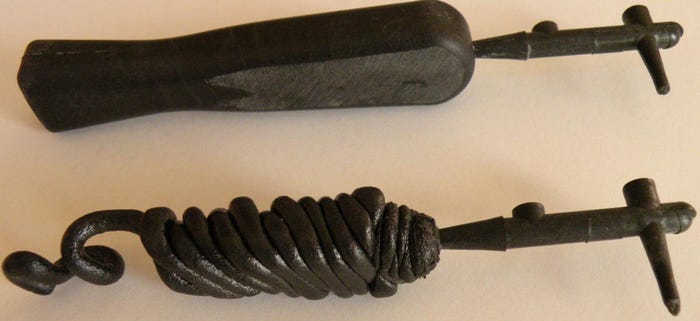Not that long ago I received a small package before lunch from the driver of the big brown truck. What I found in the little box was so interesting I just couldn't wait to talk about it.The contents of the box turned out to be handles for a screwdriver. I could see one part had been completely filled out during molding, and a second part just like it but full of jetting strings or ropes.I did not find a note in the box but then I usually do not see a note; I just wait for a call from the molder or toolmaker who is looking for an answer to solve his problem.
August 5, 2011
Not that long ago I received a small package before lunch from the driver of the big brown truck. What I found in the little box was so interesting I just couldn't wait to talk about it.
The contents of the box turned out to be handles for a screwdriver. I could see one part had been completely filled out during molding, and a second part just like it but full of jetting strings or ropes.
I did not find a note in the box but then I usually do not see a note; I just wait for a call from the molder or toolmaker who is looking for an answer to solve his problem.
The part was approximately 4 inches long, ¾ of an inch wide and a ½ inch thick. The runner was a ¼ inch diameter full-round design. The sprue dimensions were .175 where it attached to the single main runner, with a sprue "O" diameter of .110 inch. The nozzle orifice measured .090 inch.
Troublehsooter screw driver handle
The gate was basically just the ¼ inch diameter main runner tapered down to .150 inch diameter.
I did not know what the material actually was so I dug through my office drawers until I found my trusty butane lighter and burned one of the extra parts until I could figure out what it was. It turned out to be a glass-filled nylon colored black.
Now, glass-filled nylon requires a couple of things. First, it needs to be processed in the 510F - 540F melt temp range depending on how much glass is being used. Second, the gate size needs to be at least 90% of the wall into which it is being gated, but in this case that would be too large so I would default at about .150 inch.
It is important to discuss what causes jetting. It seems to always be gate related and if the depth of the gate or the gate land length is too long, then it is always possible to get jetting from the gate straight into the part. The one other thing that can cause jetting is gating directly into a cavity and not directly hitting a core that will break up the flow of material into the cavity.
It would appear that the toolmaker involved in this program knew what he was doing as far as gate depth and land length were concerned but either did not know about gating into an open cavity or forgot about it.
A better place to gate a part like a screwdriver handle is at the other end of the handle. This is where you can put a gate and have the material flow directly into the core pin that will form the hole in the part for the shank of the screwdriver.
The gate they are using now is causing the jetting but a bigger problem when it comes to production parts will be the small runner diameter and the really small sprue, which in turn causes the molding machine nozzle orifice to be way too small.
What should the sprue and runner sizing be? Easy; I pulled the trusty book that I wrote a few years ago off the shelf , looked up the page on runners and sprues, and see the main runner that will run down along the side of the part should be sized at 1 ½ times the part's wall thickness.
If I figure the core pin has a diameter of .150 inch, then the remaining wall thickness is .200 inch. When I multiply the .200-inch wall thickness times the 1 ½ number from the book, we end up with a runner diameter requirement of .300 inch.
With a runner diameter of .300 inch we will need to have a sprue bushing with an "O" diameter of .450 inch being fed by a general purpose molding machine nozzle with an orifice of .425 inch.
The gate size will be 90% of the .200 inch wall thickness, so a .180 inch diameter. The toolmaker could also use a rectangular edge gate with this part; .180 inch deep by .200 inch wide with a gate land length of .030 inch would be about right.
------------------------------
That finished my review so all I had to do to finish up was to call the molder or the toolmaker. I found the toolmaker's contact details eventually so I passed my information to him. He was happy to get the correct sizing for the runner, sprue and gate, and then he wondered if I would help him do the sizing for a new mold they are planning on building to increase production. I told him I would be glad to help; all he had to do was tell me when and where.
By this time I was working on overtime so I decided it was time to take Jake for a walk and from the wagging tail I saw it was obvious Jake thought that also would be a good idea.
About the Author(s)
You May Also Like


